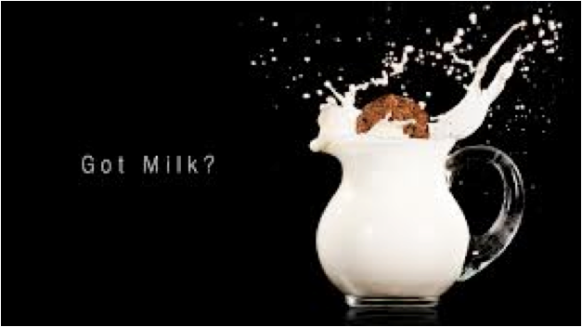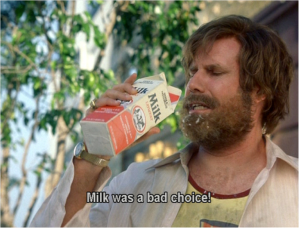The milky mysteries behind an iconic American beverage
Got Milk? We are all too familiar with this slogan, which has gained 90% household recognition according to the campaign’s website. Its no surprise, considering the tagline will celebrate its twentieth birthday this October and still continues to grace the advertisements of our most popular media. This 2007 Got Milk commercial illustrates a mother urging her children to finish their milk, a common circumstance in American culture. Milk has always been mom’s favorite beverage: nourishing, refreshing, and guilt-free. But what exactly lies behind the catchphrase we know so well? And more importantly, what lies behind our iconic vision of milk?
Let’s start by referring to another iconic image: the food pyramid. On the USDA’s MyPyramid website, one can receive personalized diet guidelines by filling out a three question survey. Generally, the results recommend three eight-ounce glasses of milk each day, on the premise that the beverage allows for development of healthy bones and teeth. This is surely common thought, as countless studies have shown correlations between calcium (highly present in milk) and bone growth. In fact, milk is the number one source of calcium in the United States (Caroli, 2011). Regardless, the USDA also points out that several other scientific studies refute this claim. The USDA’s acknowledgement of such studies exemplifies the ambiguities behind the benefits of milk, which are usually no more specific than buzzwords such as “healthy teeth & bones”, epitomized by the USDA’s description mentioned above.
Perhaps a time-machine is the answer to this nutrition question: A 2006 study in Proceedings of the Nutrition Society compared current diets in the United States to those of Paleolithic humans, arguing that past eating patterns could provide insight as to what the “optimal” modern diet might be. This claim is based on the article’s postulation that humans have not changed drastically in terms of genetics since their hunter-gatherer days, thus our ideal diets should reflect those of the past. Results showed that the Paleolithic diet was thirty percent protein (Eaton, 2006). Considering milk is marketed as a high-protein substance, it seems reasonable that dairy makes up such a large part of our diets. Notwithstanding, this study fails to account for the differences in lifestyle between contemporary humans and our ancestors: our lifestyles are much less active now, thus a diet with a 30% protein makeup would not necessarily be ideal.
The study has no mention of dairy specifically, purely because during our hunter-gatherer days, dairy was not consumed past infancy. This is because the domestication of livestock had not yet occurred, thus the only milk that humans were familiar with was a mother’s milk during the first few months of life. Research cited in this article claims that milk toleration has evolved in pastoral, human communities more than once. Moreover, there is some evidence that this adaption proves to be a biological advantage. It is logical that an immune system able to tolerate more substances, such as milk, would be preferred. But surely, there must be some major merit in drinking milk regarding the history between the beverage and us.
Famous food journalist Mark Bittman argues the other side of this story here. I enjoy his commentary both on lactose intolerance (which includes startling statistics, to say the least!) and other negative health effects of milk. Surely, if 75% of the global population (90% of Asian Americans!) is lactose-intolerant, milk cannot be considered a necessary part of the diet. If the statistics prove true, why exactly does the USDA recommend three glasses of dairy; why exactly is dairy so prevalent in our food & economy?
Many cry that the industry has a lack of integrity: thousands and thousands of dollars go into campaigns such as “Got Milk?” each year & numerous investigations show that those involved in the food pyramid and nutrition have stock in the industry’s success. The way milk is marketed contributes to its “necessary” presence in the American diet.
The fact that the industry is heavily weighed on advertising may in fact support the claim that we don’t really need milk. Notwithstanding, whether we need it or not is only half the argument behind abstaining from dairy consumption. The industry is subject to environmental problems, animal rights problems, and ethical issues, mainly because of the federal pricing system. Because fluid milk is priced as a commodity, farmers often have trouble making ends meet. Most of the money spent when one buys a carton of milk goes to middlemen, rather than the farmer. With the recent rise in feed prices, which constitute approximately 30% of a farmer’s costs on average (Coffeen, 2012), breaking even for farmers has become even more difficult. Low fluid milk prices paired with high expenses threaten the producers within the industry, as well as their ability to make healthy, sustainable choices. Many feel the need to prioritize cheaper practices over environmentally friendly & animal friendly practices. That being said, to drink or not to drink is not only a biological battle, but an ethical and social battle as well.
Perhaps these problems could be fixed if only the subject of dairy weren’t so confusing. As infants, we require milk for growth. But as we age, our relationship with the milk becomes as cloudy as the beverage itself. Milk is marketed to us as an essential in terms of obtaining adequate calcium and vitamin D, yet three-fourths of the world cannot even digest it. Additionally there are social & economic consequences of consumption, as well as potentially negative health effects. How will you weigh the conflicting pros and cons? In the end, the decision is up to you: will you raise a glass, or declare that milk indeed, was a bad choice.
Works Cited
Bittman, M. (2012, July 7). Got milk? you don’t need it. New York Times. Retrieved from http://opinionator.blogs.nytimes.com/2012/07/07/got-milk-you-dont-need-it/
Caroli, Ann. “Invited Review: Dairy Intake and Bone Health: a Viewpoint from the State of the Art.” Journal of Dairy Science 94.11 (2011): 5249-5269. Web. 10 Feb. 2013.
Coffeen, Peggy. “Dairy Producers Must Know Their Numbers, Manage Margins.” Dairy Producers Must Know Their Numbers, Manage Margins. N.p., June 2012. Web. Nov. 2012. <http://m.farmandranchguide.com/news/dairy/dairy-producers-must-know-their-numbers-manage-margins/article_e12aaa05-e1fb-5395-b146-d612354f2a8a.html?mode=jqm>.
Eaton, S. B. (2006). The ancestral human diet: What was it and should it be a paradigm for contemporary nutrition? Proceedings of the Nutrition Society, 65(1), 1-6.
Gibbons, A. (2006). There’s more than one way to have your milk and drink it, too. Science, 314(5806), 1672. Retrieved from http://www.sciencemag.org/content/314/5806/1672.1.full
By Sam Frawley
